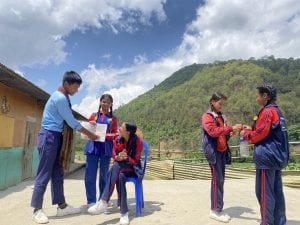Latest posts
- Curricula: Mithila art-focused local curriculum in Nepal 2 July 2025
- Register now: MAP International Online Conference 2025 1 June 2025
- Policy brief: Gira Ingoma book and policy brief: “The Culture We Want, for the Woman We Want” 28 November 2024
- Manuals and toolkits: GENPEACE Children’s Participation Module in the Development Process 13 November 2024
- Journal article: [Working Paper] Gira Ingoma – One Drum per Girl: The culture we want for the woman we want 30 October 2024
- Curricula: Beyond Tradition: Psychosocial Model 30 October 2024
- Curricula: Beyond Tradition Module: Revitalizing Lenong as a Model for Teaching Betawi Arts 30 October 2024
- Curricula: Beyond Tradition: Lenong Revitalisation as a Model for Teaching Betawi Cultural Arts 30 October 2024
- Beyond Tradition Lenong Performance “RAWR…! Kite Kagak Takut” 30 October 2024
- Journal article: [Working Paper] Facing Heaven – Déuda Folklore & Social Transformation in Nepal 30 October 2024
- Curricula: Building Community Curriculums 24 October 2024
- The Magic of Theatre Project Documentary 24 October 2024
Using a Mural and Well-being Thermometer: a creative MEL journey in Hetauda, Nepal
- Advocating for progressive education
23rd November 2023
Monitoring, Evaluation, and Learning (MEL) Note in Hetauda, Nepal by Juhi Adhikari and Sapana Lama
In August 2023, Juhi Adhikari (YAB*/Lead YAAR**) and Sapana Lama (YAB), together with a team of researchers from the University of Edinburgh, conducted a two day baseline monitoring, evaluation and learning activity with young participants in Hetauda, Nepal. The activities used two MEL tools, the Visual Mural and the Wellbeing Thermometer. These activities provided a platform for participants to express their aspirations, emotions and perspectives, ultimately facilitating a deeper understanding of participants’ needs. Let’s take a closer look at Juhi and Sapana’s experience in facilitating the MEL activities:
Activity 1: Visual Mural
In the first session, Juhi and Sapana introduced the Visual Mural to young MAP participants. To begin with, Juhi and Sapana encouraged the participants to envision their perfect imaginary world, reflecting on their individual ideals. Juhi set the tone by sharing her own ideal world, one where girls are empowered. This personal touch motivated each participant to embark on their unique creative journey, translating their visions into vibrant drawings on chart paper.
The resulting artworks were a testament to the diverse dreams and aspirations within the group. Some of the themes that emerged from their artwork were:
- No Violence
- Equal participation of people
- Support for each other
- Girls’ Education
- Men and Women supporting each other
- Family support for children’s success in life
- No generational gap
Here are some of the works of participants’ visual murals:

Beautifully portraying boys and girls working together to maintain cleanliness, symbolizing freedom and the equal participation of both genders in society. 
Reflecting on living harmoniously, with a burning candle signifying peace for the departed and a happy family unit as a model for living in unity. 
Representing multiple stories, promoting support, equality, peace, and non-violence. It also underlines the global importance of unity for a better future and advocates for love, respect, understanding, and education. 
symbolising a girl’s ascent to success, supported by her family, and encourages parents to walk hand in hand, emphasizing the importance of parental support and harmonious relationships.
Following the above activity Juhi and Sapana asked the participants to outline the changes they desired to see across five distinct levels i.e. in themselves, in their teachers, in their family, in their society and in their local level government. Through this activity, the participants not only expressed their concerns, but also became more aware of their aspirations and the change they wanted to see in their community.

Activity 2: Well-being Thermometer
Following the completion of the Visual Mural, Juhi and Sapana introduced the Well-being Thermometer activity to measure the emotional state of the participants. Rather than using a traditional rating scale, Juhi and Sapana decided to approach this in a more qualitative manner by asking the participants to write what they feel.
During this activity, the participants were asked to reflect on their experience during the two-day event and answer questions such as:
What were the things that made them hopeful?
What were the things that made them feel respected?
What were the things that made them feel connected?
What were the things that made them feel worthy?
What were the things that made them feel safe?
The participants were divided into three groups and given chart paper to write their reflections in response to these questions. They discussed and came up with what they thought were things that made them hopeful, respected, connected, worthy and safe.
The responses from all groups were noteworthy. They described feeling full of optimism and hope, as they experienced respect and a sense of connection with their fellow volunteers and new friends. The participants recognized their worth and safety within a friendly and experiential learning atmosphere. This led to strong bonds and allowed for the exchange of innovative ideas. It also served as a platform for new networking opportunities, keeping them close to their community while sharping their problem-solving techniques in a space where there was no hierarchy. In addition, participation also mentioned that teachers played a pivotal role in this environment, offering students the chance to boost their confidence and explore new cultural horizons. Peer mentors and facilitators also provide valuable connections.

Inter-generational Dialogue
Facilitating inter-generational dialogue through a co-created participatory arts-based community curriculum.
